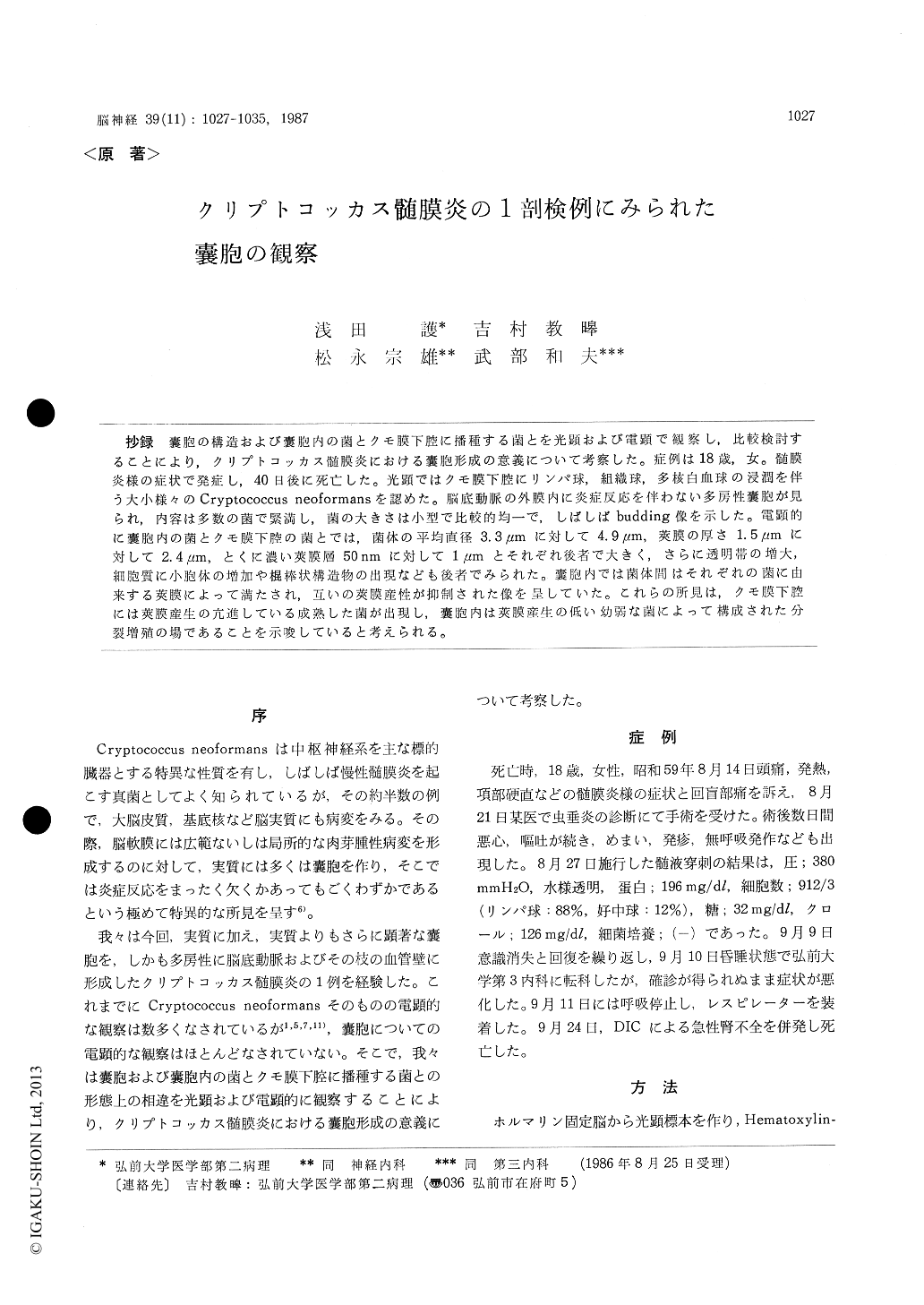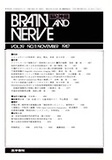Japanese
English
- 有料閲覧
- Abstract 文献概要
- 1ページ目 Look Inside
抄録 嚢胞の構造および嚢胞内の菌とクモ膜下腔に播種する菌とを光顕および電顕で観察し,比較検討することにより,クリプトコッカス髄膜炎における嚢胞形成の意義について考察した。症例は18歳,女。髄膜炎様の症状で発症し,40日後に死亡した。光顕ではクモ膜下腔にリンパ球,組織球,多核白血球の浸潤を伴う大小様々のCryptococcus neoformansを認めた。脳底動脈の外膜内に炎症反応を伴わない多房性嚢胞が見られ,内容は多数の菌で緊満し,菌の大きさは小型で比較的均一で,しばしばbudding像を示した。電顕的に嚢胞内の菌とクモ膜下腔の菌とでは,菌体の平均直径3.3μmに対して4.9μm,莢膜の厚さ1.5μmに対して2.4μm,とくに濃い莢膜層50nmに対して1μmとそれぞれ後者で大きく,さらに透明帯の増大,細胞質に小胞体の増加や棍棒状構造物の出現なども後者でみられた。嚢胞内では菌体間はそれぞれの菌に由来する莢膜によって満たされ,互いの莢膜産性が抑制された像を呈していた。これらの所見は,クモ膜下腔には莢膜産生の亢進している成熟した菌が出現し,嚢胞内は莢膜産生の低い幼弱な菌によって構成された分裂増殖の場であることを示唆していると考えられる。
We gave some considerations to the significance of cyst formation in a case of cryptococcus meningitis by examining the cysts themselves and comparing the organisms in the cysts with those disseminated throughout the subarachnoid space by light and electron microscopy.
An 18-year-old girl had complained of headache, stiffneck and fever at the onset. These symptoms worsened into confusion without any definite diagnosis, then resulted in an arrest of spontaneous respiraton which led to use of respirator for 12 days. The patient died 40 days after the onset.
The brain weighed 1440 g and showed moderate swelling with opacity of the leptomeinges, which was very evident over the convexity and around the basal side of the pons. Subarachnoid fresh hemorrhage was also observed around the basal side of the brain stem. Microscopic examination of the subarachnoid space revealed widely disseminated Cryptococcus neoformans varied in size, whose cell wall showed a positive stainning reaction to PAS. The organisms had characteristic spicules positively stained with cresyl violet radiating out of the cell body, and were associated with infiltration of lymphocytes, macrophages and polymorphonuclear leukocytes throughout the subarachnoid space. Some portions of arachnoid membrane, dura mater and vessel walls in the subarachnoid space especially the adventitia of the basilar artery were replaced by multiple cysts. The cysts were tightly filled with large numbers of small uniformly sized organisms which often showed budding. These cysts showed no histological evidence for inflammation.
Further studies to demonstrate those differences were carried out with electron microscopy. Materials for electron microscopy were obtained from the vessel wall including those cysts and thickened leptomeninges over the frontal convexity, both of which had been previously fixed with 10% formalin. The tissues were rinsed in O. 1 M PBS for 30 minutes and then fixed for 12 hours with 1 % OsO4. The following differences were observed by comparing the organisms in the cysts with those in the subarachnoid space, respectively ; 3.3 pm (max. 4.2) to 4.9 pm (max, 10. 1) for the average diameter of the cell bodies, 1.5 pm to 2.4 pm for the width of the capsules with the dense layer showing more prominent differences as 50 nm to 1 um ; the larger values associatedwith the subarachnoid space. In addition to these differences, the organisms in the subarachnoid space showed an increased width of the transparent layer, an increased number of small vesicles and occurrence of rod-like structures in the cytoplasm. In the cysts, microfibrils of the capsules which got the organisms bordered on each other completely filled the intercellular spaces, while in the subarachnoid space the capsules were separated from each other and often surrounded by numerous debris derived from macrophages, polymorphonuclear leukocytes, and collagen fibers.
In the subarachnoid space mature large organisms with abundant capsules were found. High secretion activity of the capsular material was indicated with increased width of the transparent layer, and increased number and occurrence of the cytoplasmic organella mentioned above. Onthe other hand, the small uniform organisms in the cysts seemed to be immature because they often showed budding and less abundant capsules suggesting increased secretion activity of capsular material. These observations suggest that the cysts are the sites necessary for multiplicaton and prosperation for the organisms. Bordering on each other with the capsules, which are said to have a role of inhibition to immunological response, the organisms in the cysts seem to exhibit more inhibitory effect than the separated organisms to host's inflammatory response. While such a condition seems to reduce the production of capsular material for the in dividual organisms in the cysts, it also seems to enable the organisms to use the energy for their multiplication.

Copyright © 1987, Igaku-Shoin Ltd. All rights reserved.


